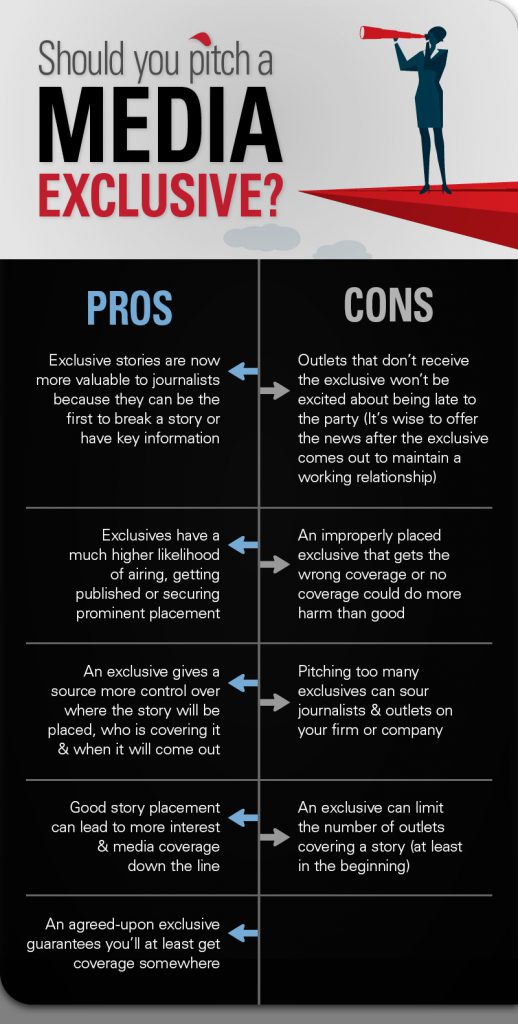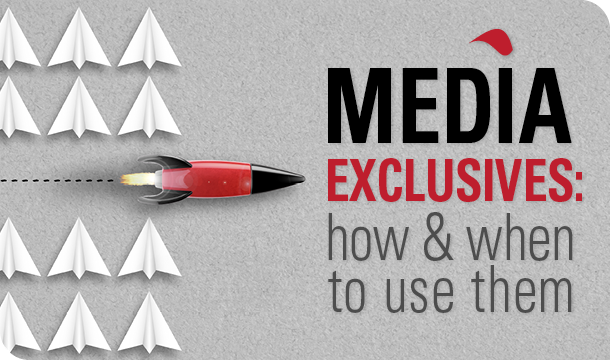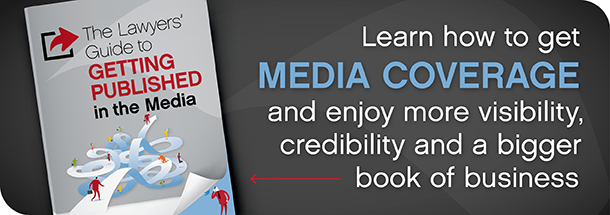Media exclusives: how and when to use them
When I was working at a television station, the first question the news director would ask after a reporter came in with a juicy story was, “Is it exclusive?”
She wanted to know if her station was the only place viewers could find the story or if they would at least be the first to break the news. In a time when just about everyone has 24/7 access to information at their fingertips, regardless of when the 5 o’clock newscast airs, media outlets are looking for any edge they can get over their competitors.
For PR purposes, exclusives can help you squeeze all of the “juice” you can get out of a story and make sure it’s placed with an outlet that will give it the coverage you think it deserves.
What are exclusives?
Depending on who you talk to, the exact definition of an exclusive varies.
The most common form of an exclusive is when a source gives a journalist or outlet an offer to be the first to publish a story before making it available for other outlets to cover.
Others consider exclusives to be stories offered to and published in only one outlet.
Depending on the story, exclusives can get different treatment. Sometimes interviews with a key figure or juicy tidbits of information are offered as exclusives — it all depends on the terms agreed upon by both parties (we’ll get to that in a moment).
What should you pitch as an exclusive? It must be something truly newsworthy. No journalist worthy of the name will bite if you offer them an exclusive on the launch of your new website. Maybe you are making a significant new hire or acquisition that will turn heads. It could also be the launch of a new service area or product. Whatever the specifics, exclusives are for something really big.

How to pitch an exclusive
- Do your research. Make sure you pitch to a journalist who actually covers your industry and can do your news justice. Look for similar stories that have handled the topic the way you want your exclusive covered and make a list of potential journalists to contact.
- Reach out. Some newsrooms list staff email addresses under the “Contact us” section of the website, and others don’t mind being contacted via online platforms like Twitter — but navigating this territory can be intimidating and time-consuming. (Partnering with a public relations agency that has established media relationships and resources can be more efficient. Wink.)
- Pitch one outlet at a time. Plan to give editors/producers a few days to accept or reject your pitch before sending it elsewhere. You don’t want two different outlets interested in the same exclusive at the same time — that could damage your credibility with both. Be clear when you send the exclusive pitch that there is a deadline for them to get back to you, or you’ll move on.
- Write the headline for them. When you send your pitch, write your subject line like it’s the headline of the story. Try to give them the “meat and potatoes” of the pitch in as few words as possible.
- Make sure to note your story is off the record until terms are agreed upon. The last thing you want to do is waste an opportunity to make your story go as far as possible by giving the outlet too much information outright. Be sure to communicate that the pitch is off the record until the exclusive is agreed upon to avoid a mixup.
Tip: Check out our post on newsroom roles to maximize every pitch.
Stipulations and best practices
- Tell everyone involved in the story (leadership, clients, partners, etc.) that you are pitching an exclusive to make sure they don’t let the story slip before publication.
- Your media contact might not be able to tell you exactly when it will air or publish early on, but you should have a rough idea of what to expect before agreeing to go with a certain outlet.
- Find out what angle they’ll be taking and the kind of coverage you can expect: where your news will be featured, what day or time-slot in which it will be published and how long of a story it will be.
- Your newsroom contact will likely ask if a press release will follow their story or if other outlets will receive the info by a certain date. Have a goal in mind, but be flexible if it aids negotiation in your favor.
- Remember, exclusives aren’t legally negotiated agreements. An exclusive is a deal of good faith between both parties to uphold the conditions of the agreement. Failing to uphold your side of the deal will hurt your reputation and could ruin your chances of working with that media outlet in the future.










Your blog post on media exclusives is incredibly helpful and informative for businesses looking to increase their media coverage and gain exposure. Here are some additional actionable tips that businesses can use to maximize the benefits of media exclusives:
Offer exclusive content: When pitching media outlets, offer them exclusive content that they can’t get anywhere else. This could be a new product launch, an interview with a key executive, or a behind-the-scenes look at your business. Providing exclusive content not only makes your business more appealing to media outlets, but also generates buzz and interest among their audience.
Pitch to the right outlets: Do your research and identify the media outlets that are most relevant to your business and your target audience. When pitching exclusives, make sure you are targeting outlets that have a large and engaged audience that aligns with your business objectives.
Time your pitch strategically: Timing is crucial when it comes to media exclusives. Pitch your exclusive content when there is a lull in the news cycle or when you have a major announcement to make. Be sure to give the outlet enough time to develop the story and promote it to their audience.
Build relationships with journalists: Developing relationships with journalists can be a valuable asset when it comes to pitching media exclusives. Take the time to build relationships with journalists by following them on social media, commenting on their articles, and attending industry events. By establishing a relationship with journalists, you increase the likelihood of them being interested in your exclusive content.
Monitor and analyze results: After the exclusive content has been published, it’s important to monitor and analyze the results. Track metrics such as website traffic, social media engagement, and brand mentions to measure the impact of the exclusive. Use this data to adjust your strategy and refine your approach for future exclusives.
In conclusion, media exclusives can be a powerful tool for businesses looking to increase their media coverage and gain exposure. By offering exclusive content, pitching to the right outlets, timing your pitch strategically, building relationships with journalists, and monitoring and analyzing results, you can maximize the benefits of media exclusives and achieve your business objectives. Thank you for sharing your insights, and I look forward to reading more of your articles in the future.